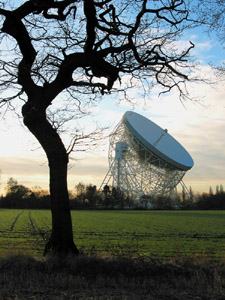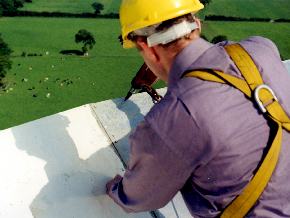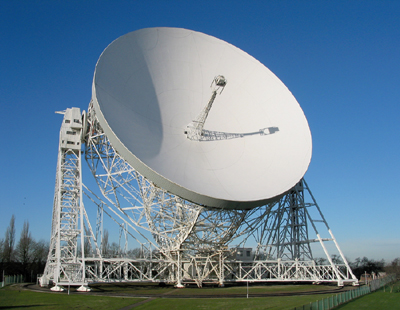The Lovell Telescope Upgrade
By the late 1990's the surface added to the telescope in 1970/1 was corroding badly and in urgent need of replacement. In 1999 a grant of over 2 million pounds, funded jointly by the UK Government and the Wellcome Foundation, was awarded to enable a new galvanised steel surface to be installed, along with replacement of the outer railway track and a new, very sophisticated, drive system to improve the telescope pointing.
Work to replace the surface
Towards the end of the first summer's work the resurfacing of alternate segments of surface was almost complete. This allowed work to begin on a further 6 segments as is shown in the next image. At the end of the first years work, 40 of the 64 segments of the upper ring will had been replaced along with just over half of the lower ring.
August 21st 2001: Work on the additional 6 segments
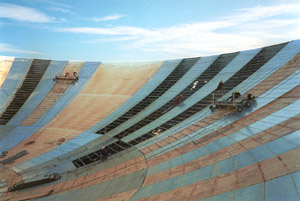
SHAL engineers, working on two of the "Bowl Excursion Vehicles" or "BEVs", are removing the last two panels to be replaced during the first summer of work. A contiguous section of 18 new panels then existed on this side of the surface. Just to the left of centre are the 4 panels installed, as a trial of the replacement techniques, in 1999. They had been stained with rust specks released when the adjacent panels were removed. Pressure washing was used to remove the stains prior to final painting in 2002.
Interior view on August 21st
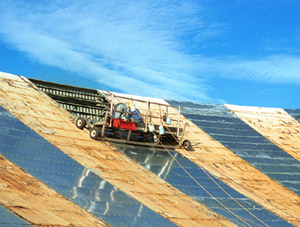
Two SHAL engineers working on one of the Bowl Excursion Vehicles (BEVs) are installing new galvanised steel panels at the top of one of the 64 sectors.
Preparing the backing structure
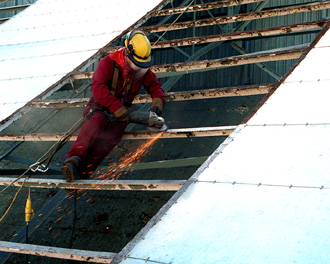
A SHAL engineer cleaning the surface of the backing structure. This will then be covered with a layer of mastic on which the new panels will be bedded and then screwed into place.
Replacing one of the surface panels

SHAL engineers working on replacing one of the surface panels. Mastic was being smoothed on the support structure as the panel was placed into position prior to being screwed in place.
Work to strengthen the central tower

Scaffolding was mounted on the tower as work to strengthen it was in progress. This will allow us to place heavier equipment in the focus box such a 7 beam "methanol" receiver. This will operate at frequencies higher than has previously been possible.
Relaying the Azimuth track
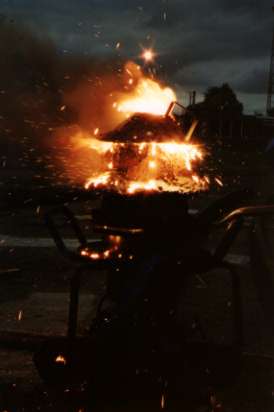
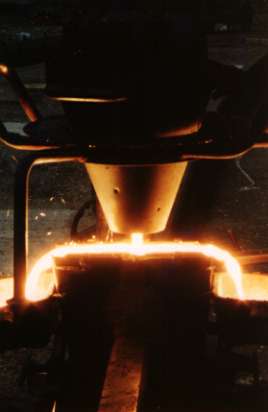
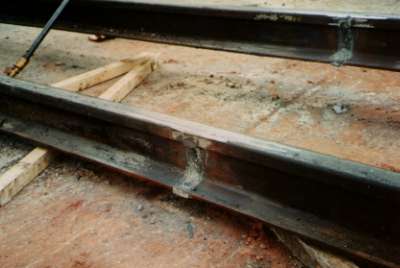
In the above images the process of laying out and welding the new outer azimuthal track sections can be seen. The SkV-F Process Thermit Welding produces both the spectacular effects and, after grinding, the smooth junction between the rails. Prior to the track relaying remedial work was carried out to prevent water ingress to the foundations on which they were laid.
The winter of 2001/2
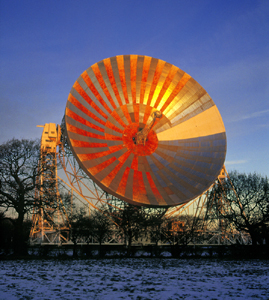
At the end of the summer's work on the resurfacing and the installation of the new drive system described below, the telescope was brought back into action until the spring of 2002. With part of the surface in its original state and part replaced, some of which had been painted, the telescope looked rather odd as the above photograph taken on Jan 2nd 2002 shows. The dawn sun was being reflected by the new panels.
A New Telescope Drive System
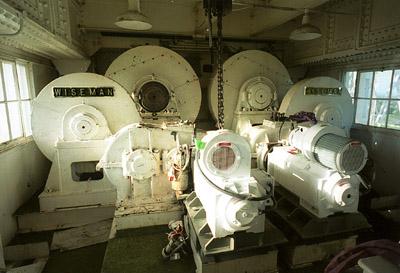
Two new Elevation Drive Motors being placed into position at the top of one of the two towers. They will be coupled to the gearboxes seen behind them which drive the rack to make the telescope rotate in elevation.
The upgraded telescope will be able to operate at significantly shorter wavelengths when the beamwidth (the area of sky from which it can receive radio signals efficiently) of the telescope will be correspondingly smaller. In order to expolit this enhanced performance the telescope must be able to "point" and "track" more accuratly to keep the radio source within the reduced beam size. The telescope has thus been equipped with a totally new,and highly sophisticated, drive and control system. Each of the four drive motors in azimuth and six in elevation has been replaced and all are driven from their own dedicated computer control system. All ten individual drive control systems ar then integrated into a unified control structure to optimise the azimuth and elevation motion of the telescope. The drive upgrade has been highly successful and has enabled the telesope to "slew" more rapidly from source to source - thus improving its observing efficiency - and can now track radio sources across the sky with far higher precision.
The new Control Desk
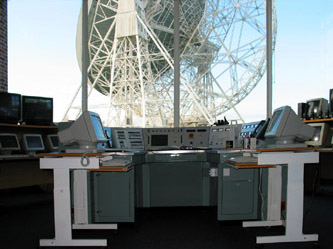
The original desk has been re-enammeled and fully re-equipped. The telescope Antenna Contol Unit (ACU) is the rectangular monitor just left of centre. To its immediate left are vertical panels associated with each of the telescope sites providing alarm indicators relating to wind and drive motors etc. To their left are wind speed and direction indicators from the anenometer mounted on a 40ft tower at Jodrell Bank. Above the ACU display is a manual control panel for direct contol of the azimuth and elevation drives. To its right are independant displays of azimuth and elevation. The two right hand panels contain meters which monitor the motor drive currents and other telesocpe parameters. The terminal in front of the right hand desk is part of the Lovell Telescope contol system and used by the controller to operate the telescope directly, whilst that in front of the left hand desk is part of the Lovell Observing Room system and is used by the controller to schedule the Pulsar observations.
The summer of 2002
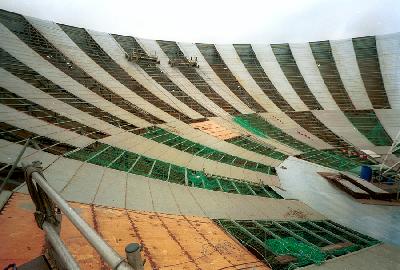
Interior view taken on June 28th 2002
Two teams of engineers were still removing the final old panels using three working platforms called "BEVs" (for Bowl Excursion Vehicles).
Interior view taken on July 10th 2002

The teams of SHAL engineers were fixing the three final galvanised steel plates necessary to complete the three central tiers. Work was commencing to complete the final 20 segments of tiers 4,5,6 and 7. In addition, preparations were being made for the cleaning of the surface prior to painting.
"Topping Out" - fitting the last panel
Following the fitting of the final panel and cleaning of the whole surface, the panels were painted with a two-coat epoxy paint to give a very long life. The telescope was then brought back into use in the autumn of 2002. One final job remains: the setting of the surface to the precise overall parabolic shape. This will be carried out during the summer of 2003, so this is where our history concludes for the time being.

